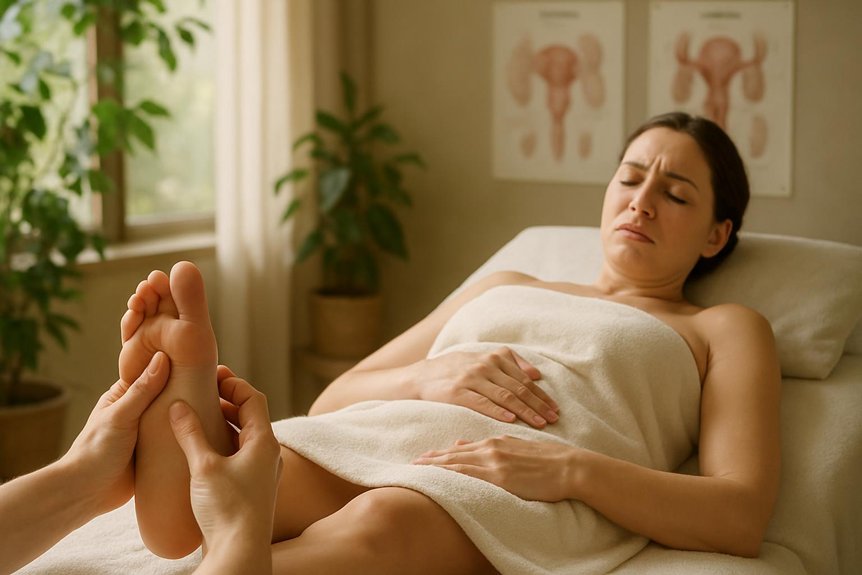Reflexology may help some people with endometriosis-related pain by modulating autonomic tone, reducing nociceptive signaling, and promoting relaxation. Gentle, graded pressure on foot reflex zones linked to pelvic organs and lumbar–sacral segments can ease dysmenorrhoea and stress, and may improve sleep. Evidence is limited and complementary; it should not replace gynecologic care, hormonal therapy, NSAIDs, or indicated surgery. Screening for red flags is essential. Appropriate pacing, pressure, and positioning support comfort. Further details explain mechanisms, safety, and integration.
Understanding Endometriosis and Common Symptoms

Although presentations vary, endometriosis is defined by the presence of endometrial-like tissue outside the uterine cavity—most commonly on the ovaries, pelvic peritoneum, and uterosacral ligaments—driven by cyclical estrogen-dependent inflammation.
Lesions can infiltrate pelvic nerves, provoke adhesions, and sensitize pain pathways. Typical symptoms include dysmenorrhoea, deep dyspareunia, chronic pelvic pain, ovulation pain, dyschezia, urinary urgency during menses, and subfertility.
Pain may radiate to the lower back or thighs and often fluctuates with the cycle.
From Spa & Massage’s clinical perspective, clients frequently describe a tender, guarded abdomen, pelvic floor hypertonicity, and sleep disruption from nocturnal cramping.
While diagnosis requires clinical assessment and, definitively, laparoscopy, supportive self-care matters.
Our therapists prioritise gentle abdominal and pelvic-adjacent soft-tissue work, breath-led relaxation, and careful positioning to reduce guarding, respecting flare patterns and individual boundaries.
Many people find that the healing power of reflexology can complement these approaches by promoting relaxation and improving overall wellbeing.
What Reflexology Is and How It Works
Reflexology is a manual therapy that applies graded pressure to mapped reflex points on the feet, hands, or ears. These points are theorized to correspond with organ systems via neurophysiological and circulatory pathways.
Proposed mechanisms include modulation of autonomic nervous system tone, nociceptive gating, and increased peripheral blood flow, which may influence pain perception and stress-related endocrine responses.
At Spa & Massage in London, therapists use precise, evidence-informed protocols to target relevant reflex zones while monitoring client comfort and physiological responses.
Reflexology Basics
How does a targeted pressure technique applied to the feet, hands, and ears aim to influence whole‑body function? Reflexology maps specific “reflex points” to organ systems via well‑defined zone charts. Practitioners apply graded, sustained pressure with thumbs and fingers to these points, evaluating tissue texture, tenderness, and temperature.
The approach does not claim to manipulate organs directly; rather, it seeks to modulate autonomic tone, circulation, and perceived pain through somatosensory input.
At Spa & Massage clinics in London, therapists conduct a brief health screen, then deliver structured sequences to plantar, palmar, and auricular reflex areas using measured pressure and pacing. Sessions emphasise comfort, breath‑synchrony, and clear boundaries.
Clients are advised to hydrate, rest, and notice symptom patterns, helping tailor subsequent sessions to individual goals and sensitivities.
Mechanisms and Effects
Building on the mapped reflex points and structured pressure sequences, the working model emphasizes neurophysiological pathways rather than direct organ manipulation.
Pressure at plantar and palmar zones stimulates cutaneous mechanoreceptors, sending afferent signals via A-beta and C fibers to spinal segments and supraspinal centers. This may modulate dorsal horn gating, dampen nociceptive transmission, and shift autonomic balance toward parasympathetic tone—mechanisms relevant to pelvic pain and stress reactivity in endometriosis.
Reflexology also appears to influence hypothalamic–pituitary–adrenal dynamics, reducing sympathetic arousal and perceived pain intensity. Improved microcirculatory responses and reduced myofascial guarding around the pelvis are plausible downstream effects.
At Spa & Massage in London, therapists apply calibrated pressures and paced breathing cues, prioritising comfort. Sessions complement—not replace—medical care, with careful adaptation during flares and menstrual phases.
Potential Benefits of Reflexology for Endometriosis
Why consider reflexology as an adjunct for endometriosis management? Evidence remains preliminary, yet targeted foot and hand reflex techniques may modulate autonomic tone, reduce perceived pelvic pain, and ease stress-linked symptom flares.
By stimulating reflex areas mapped to the uterus, ovaries, hypogastric plexus, and lumbosacral segments, practitioners aim to influence nociceptive processing and smooth-muscle tension. Small studies suggest improvements in dysmenorrhoea severity, sleep, and mood—factors that meaningfully shape day-to-day comfort.
From Spa & Massage’s clinical perspective, reflexology is positioned as supportive care alongside medical treatment, not a cure. Clients often report softer abdominal guarding, steadier breathing, and calmer cycles when sessions are scheduled around symptomatic phases.
Therapists prioritise pressure calibration, contraindication screening, and gentle aftercare advice to encourage parasympathetic recovery and sustainable relief.
What a Reflexology Session Looks Like at Spa & Massage

At Spa & Massage, each reflexology appointment begins with a brief, structured consultation to review symptoms, menstrual history, pain distribution, and any contraindications.
The therapist then applies graded pressure to specific plantar reflex zones mapped to the pelvis, uterus, ovaries, lumbar spine, and autonomic pathways, using controlled thumb-walking and static holds.
Technique intensity is adjusted to tissue response, with pacing aimed at modulating nociceptive input and promoting parasympathetic balance.
Warm Welcome and Consult
On arrival, clients are greeted, checked in, and guided to a quiet consultation area where a therapist conducts a structured intake. The discussion documents endometriosis diagnosis, current symptoms (pelvic pain, dyschezia, dysmenorrhea), cycle patterns, sleep, stress, and medication use.
Therapists at Spa & Massage note pain distribution, triggers, and red flags warranting medical follow‑up.
A brief systems review follows: gastrointestinal comfort, urinary frequency, musculoskeletal tension in lumbar, sacral, and hip regions, plus history of surgery or fertility care. Contraindications are screened, and consent is obtained.
Baseline measures—pain ratings, abdominal bloating, and perceived stress—are recorded.
The therapist explains session goals, pressure preferences, and positioning. Warm linens, neutral fragrance oils, and temperature control are offered to promote parasympathetic dominance and a sense of safe, unhurried care.
Targeted Foot Techniques
The session commences with thorough warming of the feet and ankles to enhance local circulation and prepare mechanoreceptors for precise input. At Spa & Massage, therapists then apply graded thumb-walking along plantar fascial lines, mapping reflex zones corresponding to pelvis, uterus, ovaries, sacrum, and lower lumbar segments.
Gentle sustained pressure is delivered to medial arch points (uterus/ovary reflex areas) and lateral calcaneal margins (sacroiliac representation), modulating autonomic tone and promoting parasympathetic dominance.
Targeted rotations at the metatarsophalangeal joints reduce guarding, while specific hook-and-backup techniques over the medial heel address perceived pelvic congestion.
Pressure is titrated to client feedback, avoiding nociceptive overload.
Sessions integrate diaphragmatic reflex work beneath the ball of the foot to support venous and lymphatic return.
Therapists conclude with effleurage to downregulate arousal, offering aftercare on hydration and pacing.
Safety Considerations and When to Seek Medical Advice
While reflexology is generally well tolerated, safety depends on accurate assessment, appropriate pressure, and clear boundaries with medical care. Spa & Massage advises screening for red flags: acute pelvic pain, sudden cycle changes, fever, heavy bleeding, weight loss, new bowel or urinary dysfunction, neuropathic foot pain, or pregnancy. These warrant medical evaluation before treatment.
Practitioners should avoid deep pressure over inflamed plantar tissues, varicosities, or peripheral neuropathy, and modify work for anticoagulation or clotting disorders.
Gentle, rhythmic pressure is preferable during active flare-ups, fatigue, or migraines.
Clients with endometriosis often use analgesics; therapists should note NSAIDs, opioids, or hormonal therapy, as these can mask pain responses.
Seek urgent care for severe unilateral pelvic pain, fainting, chest pain, calf swelling, or sudden shortness of breath.
Reflexology remains complementary, not diagnostic or curative.
Tips for Combining Reflexology With Self-Care and Medical Treatment
Although reflexology may modulate autonomic tone and perceived pain, ideal outcomes occur when it is integrated with a structured care plan.
Clients are encouraged to coordinate sessions with gynaecology-led management—hormonal therapy, NSAIDs, pelvic imaging, and, when indicated, surgery.
At Spa & Massage, therapists map foot points corresponding to pelvic organs, sacral plexus, and vagal pathways, then adapt pressure around menses to avoid post-session flares.
Self-care anchors the plan: paced activity, diaphragmatic breathing to downshift sympathetic drive, heat to the lower abdomen, fibre-rich nutrition to reduce constipation-mediated pelvic pressure, and sleep regularity.
Clients track symptoms, cycle timing, and triggers to inform dosage.
Clear boundaries matter—no deep pressure over inflamed regions, active infections, or suspected DVT.
Communication with clinicians ensures safe progression and measurable goals.
Conclusion
In sum, reflexology will not erase endometriosis, but for some it can feel like turning down a blaring amplifier of pelvic pain, stress, and sleep disruption. Evidence remains modest, yet targeted foot work on pelvic, hypothalamic–pituitary–adrenal, and gastrointestinal reflex zones may modulate autonomic tone, support circulation, and ease hypervigilance—sometimes astonishingly so. Within a all-encompassing plan—medical care, analgesia, nutrition, and paced activity—Spa & Massage’s protocol offers a meticulously gentle, adjunctive option that can dramatically improve day-to-day comfort and coping.